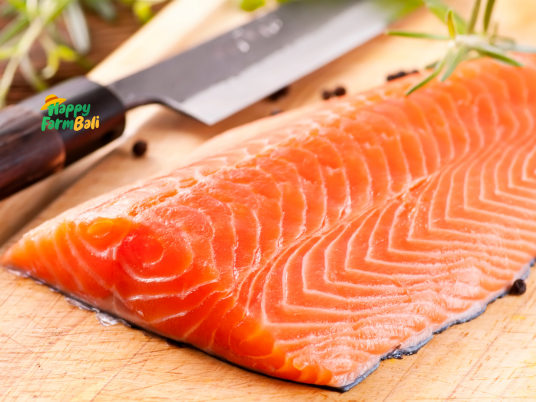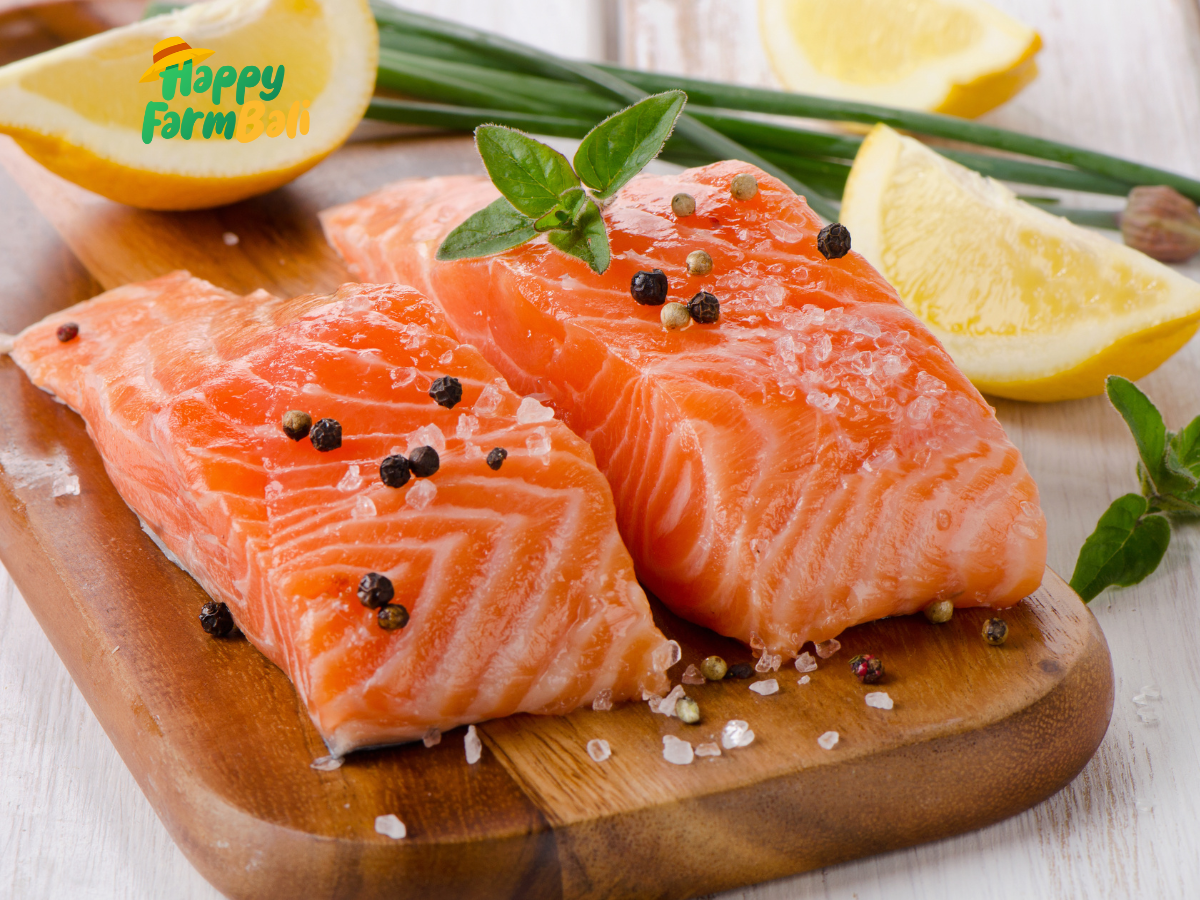Fresh Salmon Product
One of the most popular types of fish is fresh salmon due to its delicious taste and rich nutritional content, especially omega-3 fatty acids, protein, and essential vitamins and minerals. However, it is important to choose truly fresh and high-quality salmon to get the best benefits from this fish. Salmon products can be bought in the market in various forms, such as chunks, fillets, or whole fish. They are often differentiated based on where they come from, either wild or farmed. Consumers need to be observant to get the safe and best product due to the many options available.
For those who are not familiar with the characteristics of high-quality salmon, buying fresh salmon in the market can be a challenge. Factors to look out for include the color, aroma, and texture of the fish, as well as the way the seller stores it. When you choose salmon that is not fresh, you risk exposure to harmful bacteria or parasites. As a result, it is important to know how to judge the freshness of salmon before buying it.
In this article, we will provide practical advice that will help you choose better fresh salmon in the market. Seafood enthusiasts who frequently buy fresh fish or who are just trying to incorporate salmon into their daily menu will find these tips useful. You can ensure the salmon you choose is not only delicious but also nutritious by paying attention to the physical signs of the fish and understanding its origin.
Fresh Salmon
 First, if you get close enough to the salmon to smell it, you won’t smell anything and you definitely won’t smell the fish. You are looking for the refreshing aroma of the salty sea air. However, your eyes are as important as your nose in judging the freshness of the fish. Look for salmon that looks moist and not dry, as moisture content is a good indicator of freshness and how carefully the fish was handled. Avoid salmon that has brownish spots on the belly, around the edges of the fillets, or where the skin is starting to brown and curl.
First, if you get close enough to the salmon to smell it, you won’t smell anything and you definitely won’t smell the fish. You are looking for the refreshing aroma of the salty sea air. However, your eyes are as important as your nose in judging the freshness of the fish. Look for salmon that looks moist and not dry, as moisture content is a good indicator of freshness and how carefully the fish was handled. Avoid salmon that has brownish spots on the belly, around the edges of the fillets, or where the skin is starting to brown and curl.
The same goes for bruised skin or the phenomenon known as “gaping,” where the scales on the cut sides of the fish begin to detach from each other. Don’t assume that fresh fish is always better than frozen fish. “Sometimes frozen fish is better than fresh fish”. Many frozen fish are kept on ice on boats immediately after being caught to maintain freshness. Harris adds that advances in vacuum packaging technology have improved the quality of frozen fish. In short, don’t be afraid of frozen food if you trust the source.
Choosing the Best Salmon on the Market
Here are some tips for choosing fresh salmon at the market as well as recommendations on where to buy it:
Tips for Choosing Fresh Salmon
- Check out the Color of Salmon Meat
Fresh salmon has a bright flesh color, usually orange or bright pink, depending on the type. Avoid salmon that looks dull or grayish in color.
- Smell the Scent
Fresh salmon has a fresh, not pungent, marine aroma. If the salmon smells strongly fishy or rotten, avoid buying it.
- Check the Texture of the Salmon
The texture of fresh salmon meat should be chewy and firm. Press with your finger, the meat should return to its original shape, not leave marks.
- Check the Eyes and Gills
If buying whole salmon, the eyes should be bright and clear, not cloudy or sunken. The gills should also be pink or bright red, not pale.
- Look at the Moisture of the Skin
The skin of a fresh salmon looks shiny and wet. Dry skin indicates that the fish is not fresh.
- Make sure there is no excess fluid
Fresh salmon does not ooze excessive liquid. Too much liquid, especially white or greenish in color, can be a sign that the fish has started to spoil.
- Avoid Ammonia Odor
Fish that is no longer fresh will smell of ammonia. If you detect this odor, do not buy it.
- Check the Expiration Date
If the salmon has been packaged or frozen, check the expiration date or cutting date to ensure freshness.
Best Places to Buy Fresh Salmon
The price of fresh salmon is highly influenced by daily market fluctuations, making it difficult to ascertain and subject to drastic changes. The main factors affecting these prices are supply and demand in the global market, weather in the fishing areas, and distribution and shipping costs. For example, if the supply of salmon from major producing countries such as Norway or Canada decreases due to bad weather conditions, the price of salmon in the local market can increase significantly. Conversely, if there is a large harvest or a decrease in demand, prices may fall.
In addition, the price of fresh salmon can also be affected by the type of salmon being sold, such as Atlantic, Sockeye or Coho salmon, each of which has a different market value. The quality and rearing method, such as sea-caught or farmed salmon, also affect the price. Large supermarkets or fish shops usually set prices based on international market trends, so salmon prices can vary daily depending on currency exchange rate fluctuations, transportation costs, and distribution conditions.
Fresh Salmon Supplier
 Fresh salmon suppliers play an important role in maintaining the stable supply and quality of salmon received by the market, whether for individual consumers, restaurants or supermarkets. They are responsible for ensuring that the salmon distributed is always fresh and meets high quality standards, through efficient logistics systems and proper cold chain management. They must be able to manage supply fluctuations in the international market, adjust to varying demand, and maintain product availability throughout the year despite weather constraints or other external factors.
Fresh salmon suppliers play an important role in maintaining the stable supply and quality of salmon received by the market, whether for individual consumers, restaurants or supermarkets. They are responsible for ensuring that the salmon distributed is always fresh and meets high quality standards, through efficient logistics systems and proper cold chain management. They must be able to manage supply fluctuations in the international market, adjust to varying demand, and maintain product availability throughout the year despite weather constraints or other external factors.
On the other hand, fresh salmon suppliers also play a strategic role in keeping prices competitive. They need to understand global market dynamics and mitigate risks such as spikes in shipping costs or changes in currency exchange rates, which can affect the final market price. In addition, suppliers can also add value through good packaging, on-time delivery, and offering quality products, helping to maintain business reputation and customer satisfaction. With this role, suppliers not only distribute products, but also contribute to the sustainability of the fishing industry and consumer pleasure. Happy Farm Bali is known as one of the best and most trusted fresh salmon suppliers in Bali, even in Indonesia.
Providing high quality salmon that is always fresh, thanks to their efficient distribution chain management and cold chain system. With a focus on quality, they ensure that every salmon they distribute meets the best standards, both for the local market and Bali’s top restaurants. Making them the first choice for many culinary businesses that prioritize quality. In addition, Happy Farm Bali is also committed to maintaining customer satisfaction through professional service and competitive pricing. The combination of guaranteed product quality, responsive customer service, and good reputation makes Happy Farm Bali a reliable choice of fresh salmon supplier in Bali and throughout Indonesia.
